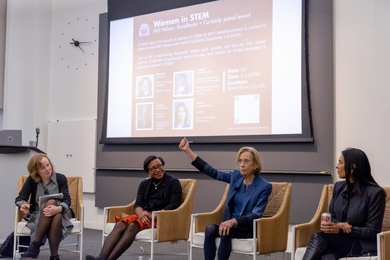CAMBRIDGE, MASS -- The MIT Department of Urban Studies and Planning (DUSP), the MIT Media Lab and the Laboratory for Computer Science (LCS) will join with the Camfield Tenants Association of Camfield Estates, a housing development in Roxbury, to celebrate the creation of a new community-based technological infrastructure program on Wednesday, September 27th at Camfield Estates, 85 Lenox Street in Boston at 6pm.
The Camfield Estates-MIT Creating Community Connections project is a collaborative effort to address issues of the "digital divide," recently identified by President Clinton as the "key civil rights issue of the 21st century."
Principal investigators of the project are Richard O'Bryant, a graduate student in DUSP, and Randal Pinkett, a graduate student at the Media Lab.
"It is our hope that Camfield Estates will demonstrate that the 'digital divide' is really a 'digital opportunity' -- an opportunity for citizens, families, and communities to use technology to achieve their goals," said Mr. O'Bryant.
(Mr. O'Bryant's father, the late John D. O'Bryant, served as a member of the Boston School Committee for over a decade and was its president in 1981 and in 1991.)
"We want the residents at Camfield to be fluent with technology. We expect to see them using technology as the creators and producers of information and content, rather than just consumers or recipients, in a way that truly builds the community," said Mr. Pinkett.
The project will implement strategies to close the digital divide in two ways.
First, the new program will bring computers and high speed Internet access into the apartment units of each resident wishing to participate in the program. Those who choose to participate will be trained in computer and Internet use, and in a specialized web application developed at MIT -- the Creating Community Connections (C3) system -- that brokers connections among residents, local organizations, and neighborhood businesses.
And second, residents who participate in the project will in turn be actively involved in running and building the program. A rigorous research agenda has been set to identify the critical success factors for using technology to build community and empowerment in a low- to moderate-income community.
Camfield Estates is a newly renovated housing development of 102 units. Residents of 33 of the 66 occupied units are enrolled in the first training session of the Camfield Estates-MIT program.
A larger goal of the Community Connections program is to establish Camfield Estates as a model for other housing developments so that residents experience greater empowerment and self-sufficiency as they make productive use of information and communications technology.
"There are going to be some great stories as a result of this project. We expect to see residents making connections to one another as well as the broader community," said Nakia Keizer, Project Leader, Camfield Estates.
Faculty advisors are Professor Mitchel Resnick, MIT Media Laboratory; Professor Joseph Ferreira, DUSP; Professor Ceasar McDowell, Director, MIT Center for Reflective Community Practice; Professor David Gifford, LCS, and Philip Greenspun, a research scientist at LCS.
The following corporate and non-profit partners are supporting the project: W.K. Kellogg Foundation, Hewlett-Packard Company, RCN Telecom Services, Microsoft Corporation, YouthBuild Boston, ArsDigita Corporation, Williams Consulting Services, Massachusetts Housing Finance Authority (MHFA), U.S. Department of Housing and Urban Development (HUD), and the William Monroe Trotter Institute at the University of Massachusetts at Boston.





